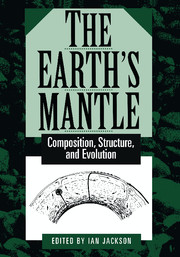Book contents
- Frontmatter
- Contents
- Chapter Outlines
- Contributors
- Dedication
- Preface
- I Accretion and Differentiation of the Earth
- II Dynamics and Evolution of the Earth's Mantle
- 4 Understanding Mantle Dynamics through Mathematical Models and Laboratory Experiments
- 5 Plates, Plumes, Mantle Convection, and Mantle Evolution
- 6 The Mantle's Chemical Structure: Insights from the Melting Products of Mantle Plumes
- 7 Pyrolite: A Ringwood Concept and Its Current Expression
- III Structure and Mechanical Behaviour of the Modern Mantle
- Index
6 - The Mantle's Chemical Structure: Insights from the Melting Products of Mantle Plumes
Published online by Cambridge University Press: 23 November 2009
- Frontmatter
- Contents
- Chapter Outlines
- Contributors
- Dedication
- Preface
- I Accretion and Differentiation of the Earth
- II Dynamics and Evolution of the Earth's Mantle
- 4 Understanding Mantle Dynamics through Mathematical Models and Laboratory Experiments
- 5 Plates, Plumes, Mantle Convection, and Mantle Evolution
- 6 The Mantle's Chemical Structure: Insights from the Melting Products of Mantle Plumes
- 7 Pyrolite: A Ringwood Concept and Its Current Expression
- III Structure and Mechanical Behaviour of the Modern Mantle
- Index
Summary
Introduction
Mantle convection can be divided into two distinct components, each driven by one of the mantle's boundary layers (Davies and Richards, 1992; Davies, Chapter 5, this volume). The outer boundary layer is cold. Oceanic lithosphere forms at the mid-ocean ridges, cools over a period of time so that it eventually becomes denser than the underlying mantle, and sinks back into the mantle at subduction zones. The plate motions associated with subduction create low-pressure zones at mid-ocean ridges that result in passive upwellings of upper mantle beneath the ridges. As this hot mantle rises, it undergoes decompressional melting to produce mid-ocean-ridge basalts (MORBs). Because the physics of the process is well understood and because the chemistry of MORBs is well documented, the chemistry of the upper mantle is well known. It is relatively homogeneous and has been depleted of the highly incompatible elements, including the light rare-earth elements, and therefore has a low 87Sr/86Sr ratio and a high 143Nd/144Nd ratio (e.g., McCulloch and Bennett, Chapter 2, this volume).
In order to unravel the chemical structure of the deep mantle it is necessary to understand the dynamics of the mantle's hot lower boundary layer. Long-lived plumes require a replenishing source of buoyancy and therefore must originate from a thermal boundary layer deep within the mantle. Their melting products provide samples of the thermal boundary layer from which they originate, as well as samples of any overlying material that is entrained into the plumes as they ascend through the mantle.
- Type
- Chapter
- Information
- The Earth's MantleComposition, Structure, and Evolution, pp. 259 - 310Publisher: Cambridge University PressPrint publication year: 1998



